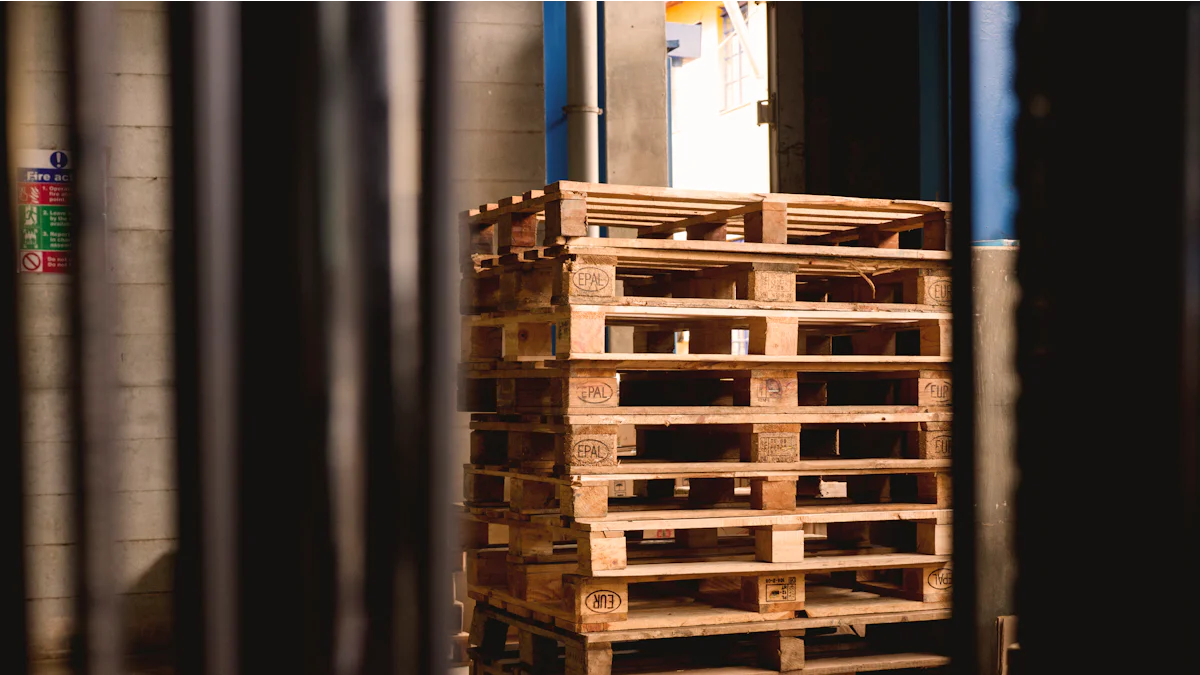
In the realm of warehouse operations, how high can you stack pallets stands as a paramount concern. Understanding the nuances of this practice is not merely a matter of efficiency but a critical component in ensuring workplace well-being. By delving into the key Pallet Jack techniques and tips, individuals can navigate the complexities of pallet stacking with finesse. However, failure to adhere to proper protocols can result in dire consequences, ranging from inefficiencies to potential hazards that jeopardize both personnel and productivity.
Importance of Safe Pallet Stacking
Risks of Improper Stacking
Workplace Accidents
When pallets are stacked improperly, the risk of workplace accidents escalates significantly. Employees may be exposed to hazardous situations that can lead to severe injuries. Adhering to safety protocols and stacking guidelines is crucial in mitigating these risks. By following OSHA guidelines for pallet stacking, organizations can create a secure environment that prioritizes employee well-being.
Product Damage
Improperly stacked pallets not only pose a threat to employees but also increase the likelihood of product damage. The instability caused by haphazard stacking methods can result in goods falling or getting crushed, leading to financial losses for businesses. To prevent such scenarios, it is essential to implement proper stacking techniques that ensure the safety of both personnel and products.
Benefits of Proper Stacking
Increased Efficiency
Proper pallet stacking goes beyond safety considerations; it also enhances operational efficiency within a warehouse setting. When pallets are stacked securely and in an organized manner, it streamlines inventory management processes and facilitates smoother material handling operations. This efficiency boost translates into time savings and improved productivity for the entire supply chain.
Enhanced Safety
One of the primary advantages of adhering to safe pallet stacking practices is the overall enhancement of workplace safety. By maintaining stable stacks that comply with industry standards, organizations create a secure environment where employees can perform their duties without unnecessary risks. Prioritizing safety through proper stacking techniques fosters a culture of well-being and accountability among staff members.
Regulatory Compliance
OSHA Guidelines
Compliance with OSHA regulations regarding pallet stacking is not just a legal requirement; it is a fundamental aspect of ensuring occupational safety. These guidelines outline specific measures that organizations must follow to prevent accidents and injuries related to pallet handling. By aligning with OSHA standards, businesses demonstrate their commitment to creating a hazard-free workplace.
Industry Standards
In addition to OSHA regulations, industry-specific standards play a vital role in governing safe pallet stacking practices. Adhering to established norms set forth by organizations like the National Wooden Pallet & Container Association (NWPCA) and International Organization for Standardization (ISO) reinforces the importance of quality assurance and risk mitigation in warehouse operations. Following these standards contributes to a harmonized approach towards safety across the industry landscape.
By understanding the risks associated with improper stacking, recognizing the benefits of proper techniques, and ensuring regulatory compliance through established guidelines, organizations can cultivate a culture of safety and efficiency in their pallet handling processes.
Techniques for Safe Pallet Stacking

When considering how high can you stack pallets, it is essential to prioritize safety and stability above all else. Adhering to proper height limits and addressing stability concerns are paramount in ensuring a secure warehouse environment. By following industry guidelines and best practices, organizations can mitigate risks associated with improper stacking techniques.
How High Can You Stack Pallets
Maintaining awareness of height limits is crucial to prevent accidents and injuries in the workplace. According to OSHA regulations for stacking pallets, exceeding recommended heights can pose significant hazards. By adhering to these guidelines, businesses demonstrate their commitment to employee safety and risk reduction.
Height Limits
- Follow OSHA guidelines on maximum stacking heights to avoid potential dangers.
- Exceeding height limits increases the risk of accidents and structural instability.
Stability Concerns
- Ensure that stacked pallets are stable and securely positioned at all times.
- Address any stability concerns promptly to prevent collapses or toppling incidents.
Forming a Strong Base
Establishing a robust base for pallet stacks is fundamental in maintaining overall stability and preventing mishaps. By implementing effective base layer techniques and distributing weight evenly, organizations can enhance the structural integrity of their pallet stacks.
Base Layer Techniques
- Utilize sturdy pallets as the foundation for building stable stacks.
- Implement cross-stacking methods to reinforce the base structure effectively.
Weight Distribution
- Distribute weight evenly across each layer of stacked pallets.
- Avoid placing excessive weight on individual pallets to maintain balance throughout the stack.
Grouping Like Pallets
Grouping similar pallet types together streamlines stacking processes and minimizes the risk of imbalances or collapses. By maintaining balance within the stack and proactively preventing potential hazards, organizations can optimize their warehouse operations efficiently.
Maintaining Balance
- Arrange similar-sized pallets together to ensure uniformity in the stack.
- Regularly inspect stacked pallets for any signs of imbalance or shifting.
Preventing Collapse
- Monitor stacked pallets closely for any indications of instability.
- Implement corrective measures immediately upon detecting potential collapse risks.
By prioritizing safe stacking practices, including observing height limits, forming a strong base, and grouping like pallets together, organizations can uphold workplace safety standards effectively while optimizing operational efficiency within their warehouses.
Avoiding Manual Stacking
When it comes to pallet stacking, using equipment is a fundamental practice that enhances both safety and efficiency in warehouse operations. By leveraging specialized tools such as pallet jacks, organizations can streamline the stacking process and minimize the risks associated with manual handling. These equipment not only facilitate the lifting and movement of heavy pallets but also reduce the strain on employees, preventing potential injuries.
Using Equipment
- Implementing pallet jacks in stacking operations significantly improves productivity and safety.
- By utilizing these tools, organizations can efficiently transport pallets without manual lifting.
- Pallet jacks come in various types, including manual and electric models, catering to different operational needs.
- Regular maintenance and inspection of pallet jacks are essential to ensure optimal performance and longevity.
Preventing injuries is a top priority for any workplace environment, especially when it involves tasks like pallet stacking. Manual handling of heavy loads poses significant risks to employees’ well-being and can lead to musculoskeletal disorders if proper precautions are not taken. By avoiding manual stacking practices and opting for equipment-assisted methods, organizations safeguard their workforce against potential harm.
Preventing Injuries
- Minimizing physical strain on employees through equipment usage reduces the likelihood of work-related injuries.
- Training programs on safe equipment operation should be provided to all staff members involved in pallet stacking activities.
- Encouraging a culture of safety awareness among employees fosters a proactive approach towards injury prevention.
- Reporting any equipment malfunctions or safety concerns promptly ensures a secure working environment for all personnel.
Designated Stacking Areas
Establishing safety zones within warehouse facilities is crucial for maintaining order and preventing accidents during pallet stacking operations. These designated areas serve as dedicated spaces for stacking activities, ensuring that they are conducted away from high-traffic zones or walkways. By clearly demarcating safety zones, organizations create a structured environment that prioritizes both employee safety and operational efficiency.
Safety Zones
- Clearly mark designated stacking areas with visible signage to guide employees on proper stacking locations.
- Restrict unauthorized personnel from entering safety zones to prevent disruptions during stacking procedures.
- Regularly inspect safety zones for any potential hazards or obstructions that may compromise workplace safety.
- Implementing regular safety audits ensures compliance with established protocols and identifies areas for improvement.
Easy access to stacked pallets is essential for seamless material handling processes within warehouse settings. Designated stacking areas should be strategically located to facilitate efficient loading and unloading operations while minimizing congestion in high-traffic regions. By optimizing accessibility to stacked pallets, organizations enhance workflow efficiency and reduce the risk of bottlenecks during logistical operations.
Easy Access
- Position stacked pallets in designated areas that allow easy access for material handling equipment such as forklifts.
- Maintain clear pathways around stacked pallets to enable smooth navigation for warehouse personnel.
- Implement inventory management systems that track the location of stacked pallets within designated storage zones.
- Regularly review access points to stacked pallets to identify opportunities for process optimization and workflow enhancement.
Common Mistakes to Avoid
Overloading Pallets
Weight Limits
- Adhering to weight limits is crucial for maintaining the structural integrity of pallet stacks.
- Exceeding specified weight capacities can lead to instability and potential hazards in the workplace.
- By following OSHA regulations on weight limits, organizations prioritize safety and risk mitigation.
Signs of Overloading
- Recognizing signs of overloading is essential to prevent accidents and product damage.
- Sags or deformations in stacked pallets indicate excessive weight and require immediate attention.
- Regular inspections help identify overloading issues before they escalate into safety concerns.
Ignoring Base Stability
Consequences
- Neglecting base stability can result in collapses, causing injuries and operational disruptions.
- Unstable bases compromise the entire stack’s security, posing risks to both personnel and products.
- Addressing base stability issues promptly is critical to prevent accidents and maintain a safe working environment.
Prevention Tips
- Implementing cross-stacking techniques enhances base stability by distributing weight effectively.
- Using sturdy pallets as the foundation strengthens the overall structure of pallet stacks.
- Regular maintenance checks on base layers ensure early detection of stability concerns.
Improper Use of Equipment
Training Importance
- Providing comprehensive training on equipment operation reduces the risk of mishaps during stacking.
- Properly trained staff can handle automated palletizing systems efficiently, enhancing workplace safety.
- Training programs instill best practices for equipment usage, promoting a culture of operational excellence.
Equipment Maintenance
- Regular maintenance schedules for automated palletizing systems prolong their lifespan and optimize performance.
- Timely repairs and inspections prevent unexpected breakdowns that may disrupt warehouse operations.
- Following manufacturer guidelines for equipment maintenance ensures consistent reliability and functionality.
- Highlighting the risks of improper stacking is crucial for workplace safety and efficiency.
- Emphasizing the benefits of proper techniques ensures a secure environment for all.
- Final thoughts underscore the significance of meticulous pallet stacking practices in preventing injuries and enhancing operational productivity.
What Are the Hazards of Palletizing and Stacking?
- Palletizing and stacking account for more than 60% of all warehouse injuries.
- Discusses the consequences of overloading pallets.
Post time: Jun-18-2024
